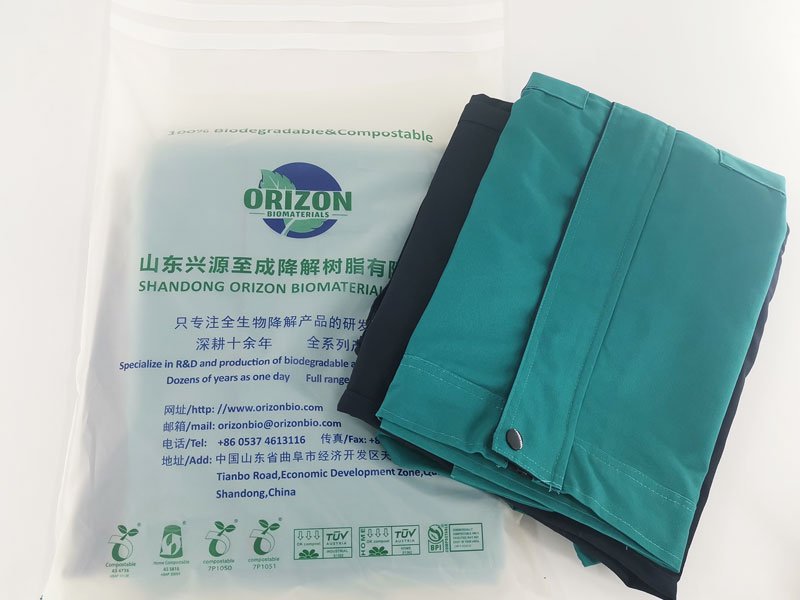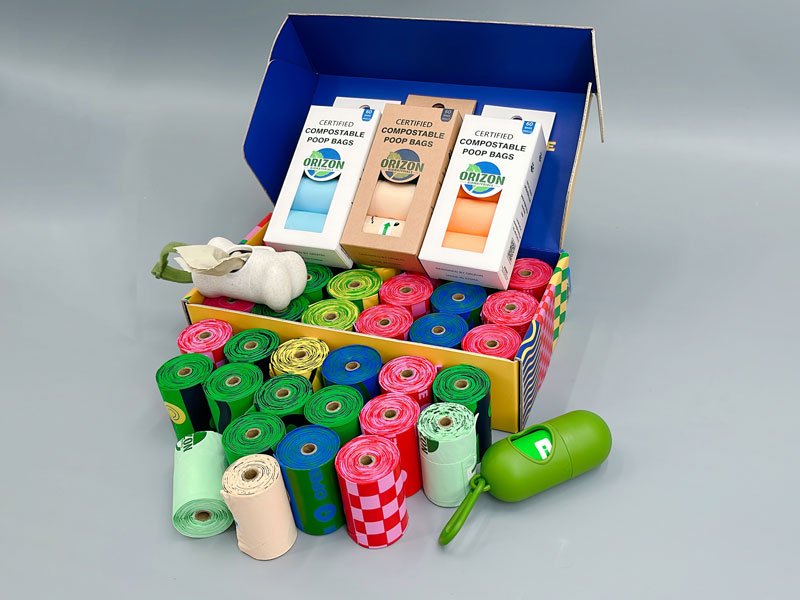The fashion industry, a hub of creativity, is also a major environmental culprit, consuming 98 million tons of non-renewable resources annually and emitting 50 billion tons of carbon dioxide, roughly 9% of global greenhouse gas emissions (ScienceDirect). Plastic packaging, especially single-use bags, exacerbates this issue, lingering in landfills for centuries and releasing microplastics. Biodegradable bags fashion industry solutions, such as eco-friendly clothing bags and compostable garment bags, offer a path to reduce this impact. These sustainable packaging bags, made from materials that decompose naturally, are gaining traction in e-commerce and retail.
This blog explores how biodegradable bags are applied in fashion, their benefits, challenges, and future potential, guiding brands toward a greener future.
What Are Biodegradable Garment Bags?
Biodegradable Garment Bags are designed to break down into water, carbon dioxide, and biomass, minimizing environmental harm. Unlike traditional plastic bags, which persist for centuries, these bags decompose faster, often within months under the right conditions.
Types of Biodegradable Garment Bags
- Biodegradable Bags: Made from plant-based plastics like corn starch or bio-based plastics, these bags decompose in landfills or soil. ECO Garment Bags’ Hydropol™ bags, for example, fully biodegrade in 12 months, leaving no harmful residues (ECO Garment Bags).
- Compostable Bags: A subset of biodegradable bags, these turn into nutrient-rich compost in industrial composting facilities or, in some cases, home composters. TIPA’s compostable clothing bags decompose in 6-12 weeks industrially or 24 weeks at home (TIPA).
- Water-Soluble Bags: Made from materials like PVA, these dissolve in water but may not always be fully biodegradable, raising concerns about microplastics (The Circular Laboratory).
Materials
- Corn Starch and Cassava: EcoPackables uses D42 film from cassava root and cornstarch for 100% compostable bags (EcoPackables).
- Hydropol™: A hydrophilic polymer that dissolves in water, used by ECO Garment Bags.
- Bacterial Cellulose: An emerging material for sustainable textiles and packaging (Springer).
Certifications
- BPI Certification: For industrial composting in North America.
- OK Compost Industrial: For European industrial composting.
- OK Compost Home: For home composting.
- TUV, ABA, Vincotte: EcoPackables’ bags meet multiple international standards (EcoPackables).
Proper disposal is key. Compostable bags need composting facilities, while biodegradable bags can break down in landfills but may take longer without optimal conditions.
Compostable Clothing Bags Applications in the Fashion Industry
Biodegradable bags serve multiple roles in fashion, addressing packaging needs while aligning with sustainable fashion goals.
E-commerce Packaging
The boom in online shopping has spiked packaging demand. Biodegradable garment bags protect clothes during shipping, reducing plastic waste. TIPA’s bags, used for dresses, t-shirts, and suits, are lightweight, durable, and printable for branding (TIPA).
Retail and In-Store Use
Retailers replace plastic shopping bags with green packaging bags to meet regulations and appeal to eco-conscious shoppers. These bags can feature custom logos, enhancing brand identity.
Brand Examples
- Rhythms by Design and Gabriela Hearst use TIPA’s compostable bags to eliminate plastic packaging (TIPA).
- C&A partners with Traceless Materials for biodegradable in-store hooks, cutting carbon emissions by up to 95% (Packaging Gateway).
- Nike emphasizes sustainability through its ‘Move to Zero’ initiative, incorporating recyclable clothing bags (Packaging Gateway).
These applications show how biodegradable bags integrate into fashion’s supply chain, from production to consumer hands.
Benefits of Biodegradable Bags
Biodegradable bags offer environmental, business, and consumer benefits, making them a compelling choice for fashion brands.
Environmental Benefits
- Plastic Pollution Reduction: Unlike traditional plastics, biodegradable bags decompose quickly, reducing landfill waste. Hydropol™ bags leave no microplastics after 12 months (ECO Garment Bags).
- Lower Carbon Footprint: Plant-based materials like corn starch reduce fossil fuel reliance, and composting can further lower emissions.
Consumer Appeal
- Eco-Conscious Consumers: 78% of consumers seek eco-friendly products, boosting loyalty for brands using sustainable packaging (Packaging Gateway).
- Brand Image: Adopting green packaging solutions differentiates brands in a competitive market.
Regulatory Compliance
- Single-Use Plastic Bans: Over 400 cities enforce plastic bans, and biodegradable bags ensure compliance (National Geographic).
- Extended Producer Responsibility (EPR): These bags simplify end-of-life management, aligning with EPR regulations.
Cost Savings
- Incentives: Governments offer subsidies for sustainable practices.
- Waste Management: Reduced non-biodegradable waste lowers disposal costs.
- Scale Economies: Rising demand may decrease production costs over time.
| Benefit | Details |
|---|---|
| Plastic Pollution Reduction | Decomposes in 12 months, no microplastics (ECO Garment Bags) |
| Consumer Appeal | Attracts 78% of eco-conscious shoppers (Packaging Gateway) |
| Regulatory Compliance | Meets global plastic bans (National Geographic) |
| Cost Savings | Subsidies and lower waste fees |
Challenges and Considerations
Despite their promise, biodegradable bags face hurdles in the fashion industry.
Disposal Education
Consumers often lack knowledge on disposing compostable bags, which need industrial composting facilities. Incorrect disposal reduces benefits (Forbes). Brands must educate via labels and campaigns.
Infrastructure Limitations
Limited composting facilities hinder compostable bags’ effectiveness. In areas without facilities, bags may end up in landfills, decomposing slowly (Forbes).
Higher Costs
Biodegradable bags cost 1.5-2 times more than plastic, challenging smaller brands (Treehugger). Incentives and bulk discounts can help.
Durability Concerns
Some perceive biodegradable bags as less durable, with thicknesses of 20-110µm Ascertainable Data: biodegradable bags fashion industry bags are typically thinner (0.015-0.05 mm) than traditional bags (15-80 microns) (Universal Plastic). High-quality options like EcoPackables’ bags (20-110µm) address this (EcoPackables).
Trust and Standardization
Studies suggest some biodegradable bags, like PVA, may not decompose well in oceans, raising greenwashing concerns (The Circular Laboratory). Certifications like BPI or TUV ensure credibility.

Choosing the Right Biodegradable Bags
Types
- Landfill-Biodegradable: Ideal without composting facilities, like ECO Garment Bags’ Hydropol™ (ECO Garment Bags).
- Compostable: For areas with industrial composting facilities, like TIPA’s bags (TIPA).
- Home-Compostable: Less common, suitable for home composters.
Certifications
- BPI, OK Compost, TUV: Ensure decomposition standards.
- EcoPackables’ bags meet TUV, ABA, and BPI standards (EcoPackables).
Materials
- Plant-Based: Corn starch, cassava.
- Bio-Based: May include petroleum components.
- Hydropol™: Dissolves in water, marine-friendly.
Suppliers
- TIPA: Customizable compostable bags (TIPA).
- ECO Garment Bags: Hydropol™ bags, minimum 4000 units (ECO Garment Bags).
- EcoPackables: 100% compostable bags, 5000-unit minimum (EcoPackables).
Where to Buy
- Direct from TIPA, ECO Garment Bags, or EcoPackables.
- Online retailers like Amazon, but verify certifications.
Implementing Biodegradable Bags
Assess Needs
Evaluate bag volume, garment types, and local disposal options.
Source Suppliers
Partner with certified suppliers for quality assurance.
Train Staff
Educate on benefits and disposal to inform customers.
Educate Customers
Use labels, websites, and social media to guide disposal.
Market Sustainability
Highlight eco-friendly clothing bags in marketing to attract eco-conscious consumers.
Monitor Feedback
Adjust based on customer input on bag performance.
Future of Sustainable Fashion Packaging
The fashion industry is shifting toward sustainability, with biodegradable bags at the forefront.
Material Innovations
Bacterial cellulose and algae-based plastics promise better performance (Springer).
Infrastructure
Expanding composting facilities supports compostable bags.
Regulations
Plastic bans and EPR schemes drive adoption (National Geographic).
Consumer Demand
Growing awareness fuels demand for sustainable packaging.
Conclusion
Biodegradable bags are transforming the fashion industry by reducing plastic waste, meeting regulations, and appealing to eco-conscious consumers. Despite challenges like disposal education and costs, strategic implementation—choosing certified bags, educating customers, and marketing sustainability—can maximize impact. With innovations in materials and infrastructure, biodegradable bags will shape a greener future for fashion.



